Tips for Traveling in Europe with a Baby
Both of our kids have caught a travel bug early and love being surrounded by new environments. As they were born in other countries, by choice, they’ve been traveling pretty much instantly – since they were 2 weeks old and long-haul at 4 weeks for Dylan and 6 weeks for Holden.
While traveling with a baby requires more preparation it doesn’t mean that it’s going to be tough and make your travels suck. Quite the opposite actually.
Traveling with babies is definitely easier than with toddlers. When the baby doesn’t walk yet, things are surely easier as you don’t need to chase him around.
A few things to keep in mind before we start:
Each baby behaves slightly differently, so you need to be flexible and adjust to his or her needs and prepare your baby travel products wisely.
While it may sound tempting to take your first holidays with another family with a baby, I’ll say don’t do it… Babies have different schedules, parents have different levels of comfort, and the little ones can anger themselves by crying. Plus, you might see your friends rarely and just get frustrated trying to coordinate schedules (been there, done that, sadly).
Tips for Traveling in Europe with a Baby
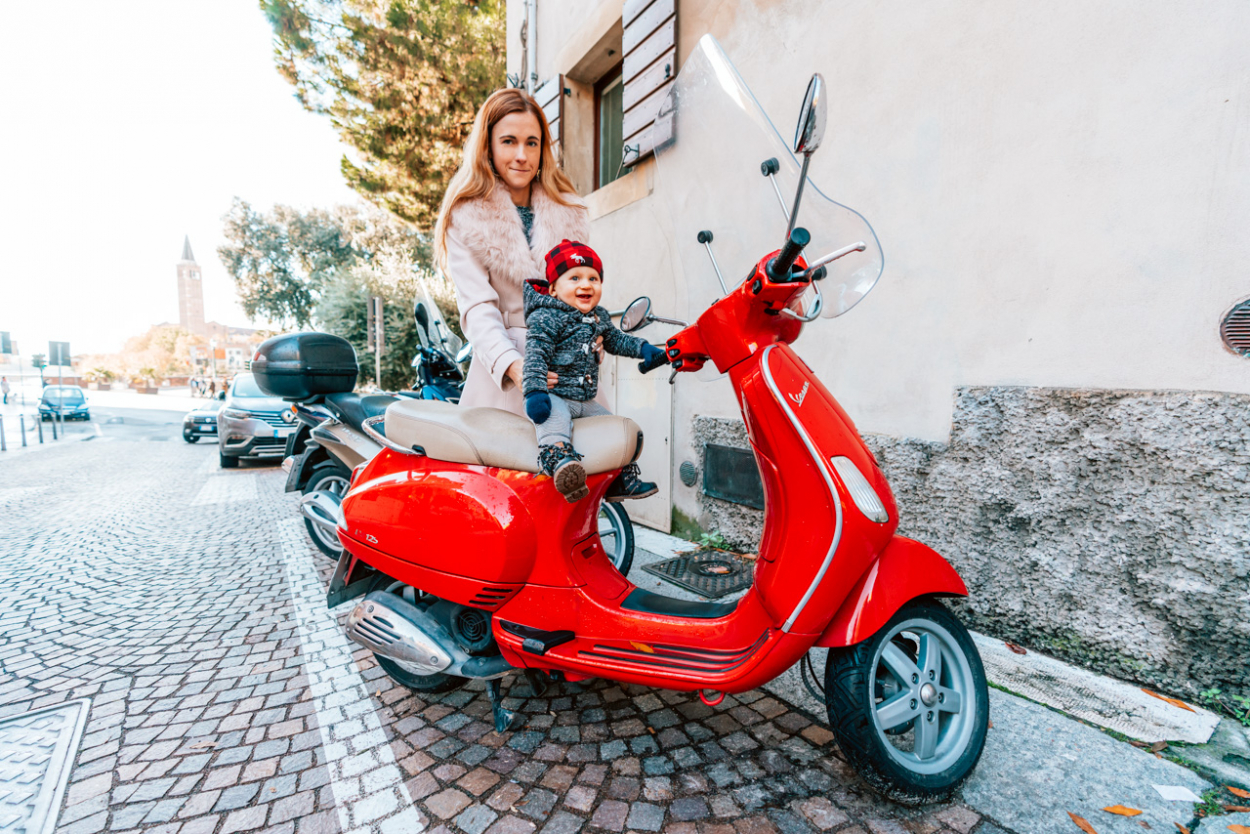
Baby Health Insurance
Babies get sick a lot, so you need to start thinking of travel insurance, even if you previously haven’t. While you should always have health insurance when you travel even without your family, with babies it’s a must.
The good news is that quite often you can just add your baby to your own policy without an extra charge. We did it numerous times with Safety Wing and actually had to use it for unexpected doctor’s visits when he suddenly got eczema flair.
Booking Flights for Your Baby
Unlike in the US, where babies under 2 fly for free and don’t need a passport, in Europe you have to pay for their flights and have their passport.
Without a valid ID, your infant will not be able to fly and you’ll be stranded at the airport. A birth certificate does NOT count as an ID.
You also need to pre-book your baby’s ticket online at the same time you’re booking yours, unlike in the US when you need to call the airline to add an infant in arms to your ticket.
Don’t worry though, it’s not a fully-priced ticket. You usually need to pay 10% of the regular fare, or a special baby fare on cheap airlines like Ryanair or Wizzair.
You can book an extra seat for an infant, but then the child has to be restrained in a car seat. Keep in mind that many European carriers don’t allow infant car seats (or those rear-facing) because they limit the recline. I’ve been on over 500 flights all over Europe and only once I’ve seen someone flying with a car seat so it’s just not a common practice.

Does Traveling with a Baby Give You Priority? Not always.
One of the most common things I read on other blogs is that traveling with a baby gives you priority. Jumping the queue at the car rental office, priority boarding, and so on.
Let me tell you honestly that’s only partially true and NEVER count on it. I’ve never had anyone let me skip the line at the rental car place just because of the baby. Quite often when traveling in Italy when Dylan was just a month old we had to sit on the sidewalk in the sun waiting for half an hour for the attendant to finally give us a car.
Even when the sign says there’s a priority for pregnant women and babies it doesn’t mean that you’ll always get it automatically. You can ask, but it’s not guaranteed. When re-entering the US we always had to wait in line for a long time, regardless of the airport.
There were many other families with kids around us and everyone was in the same situation. It just doesn’t work that way, even if your baby is screaming his lungs out.
Europeans also travel with their babies and kids more often than Americans. That means that when they call for priority boarding for families it means at least 40 people are boarding with you. I remember one time on a flight from Rome to Boston pretty much every single family had a baby or toddler with them.
Also, if you need to reach your plane from the gate by bus (which is super common in Europe) forget about any priority. You’ll be able to get onto the bus first, but then everyone will push out to the plane. Unless you have your stroller folded and ready to move forward with determination you’re probably going to be the last on the plane (this is why you need a lightweight travel stroller to take on board, not to leave at the gate).
Most airports in Europe have a special family lane for security, but it doesn’t do much. You often end up in the same line as everyone else after skipping a few people in front of you. In my experience families naturally move slower through security, so I tend to rather stand behind single travelers so the line moves quickly.
I’ve had good or bad experiences when going through security, but let me tell you one thing – even at the same airport the rules could be different depending on the day.
One day you’ll be able to roll your baby through the X-ray in the stroller, the other time you need to take your baby out. One day you have to fold the stroller and put it on a screening belt, another time they want you to swab it. There’s no one set of rules anywhere.
One thing is always clear though: even if your baby is fast asleep in your baby carrier you cannot walk through the X-ray machine with him in a carrier. The same things happens during take-off and landing and in case of turbulences, as you need to put the seatbelt on your baby. You’ll be forced to take the baby out, hence why I think baby carriers for airports aren’t always great.
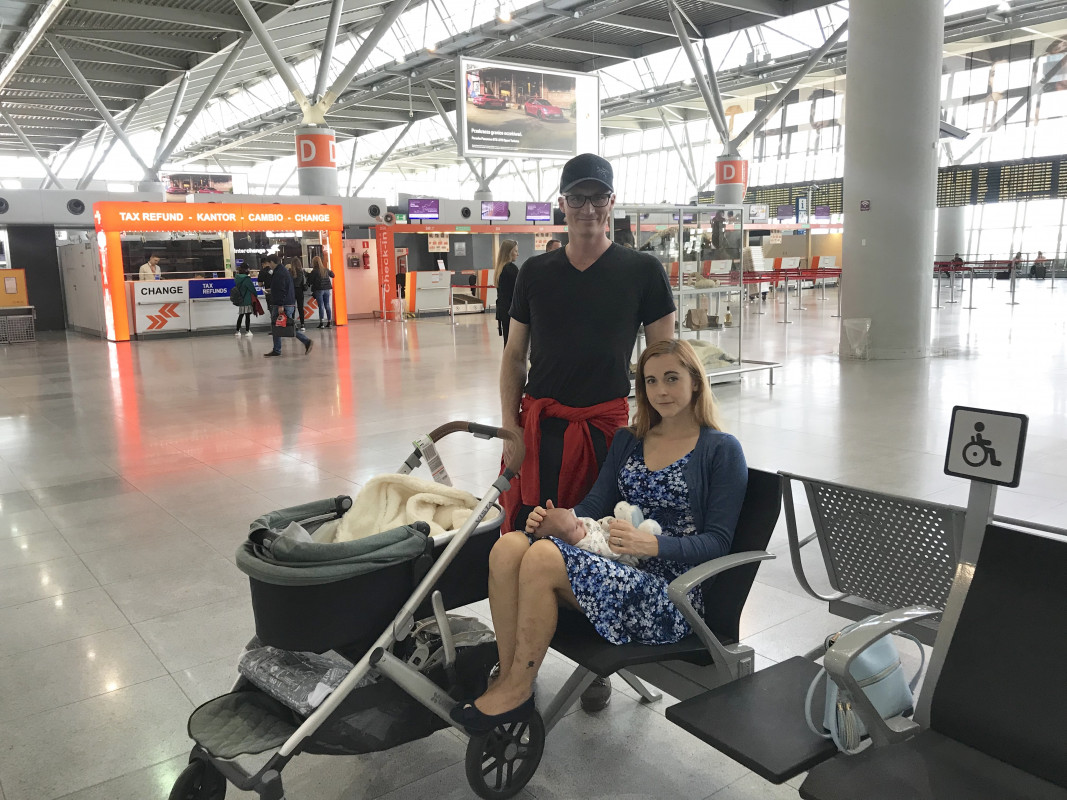
Seatbelts for Babies on Planes
The biggest difference between American flights and European flights is seatbelts. In the US when your baby flies on your lap you just need to hold them.
In Europe, you’ll be given a baby seatbelt that’s an extension of your own seatbelt. Naturally, both continents think that what the other one is doing is unsafe and wrong.
Same with car seat regulations as car seats are different in Europe than they’re in the USA (more on this further down AKA why don’t bring your car seat to Europe).
More Tips on Flying with a Baby
Do You Need a Special Travel Stroller for Europe? What Makes A Great Travel Stroller For Europe?
YES, you do need a smaller stroller for traveling around Europe. It will make your trip undeniably easier.
If anyone reading this has ever traveled to Europe with a big American stroller like my Uppababy Vista (which works in the US for one child, I used to have it), you know it’s a pain in the butt. Save yourself some nerves and leave this giant monster at home.
Oh, and stroller wagons are NOT a thing in Europe. 20+ years I spent in Europe I’ve never seen anyone with it anywhere and when I show all my European friends that these are popular they laugh that it looks like a farm truck. Unless you want to get the looks, don’t (I know, I’ve taken mine to Vienna once, LOL!)
While I love strolling with our stroller wagon in the US, when I’m in Europe it’s simply sitting in our rental apartments untouched while I roll around with a travel stroller. Why?
a) Doorways are Small
First of all: doors. In places like Italy or France doors are smaller, and you won’t be able to enter many places with a giant monster truck, as we named our Uppababy stroller.
In fact, I couldn’t even leave my own apartment in Italy (where we lived) without having to open an extra set of heavy doors. The next time we moved to Europe and traveled around France and Switzerland we just took small Babyzen Yoyo and Cybex Libelle.
When I visited some friends or hotels there was no way it could fit. In Rome, we had to fold the stroller every time entering the elevator at the hotel, which was super annoying.
Not to mention that I couldn’t even enter some aisles in the supermarket with a big stroller either. Side by side double stroller is absolutely out of the question as it takes an entire sidewalk.
Almost all families use two single strollers. When it’s not possible because only one parent is present, then for two kids a single stroller with a buggy board works best.
b) You Can’t Take Your Stroller Inside Many Restaurants
Many charming restaurants and cafes are short on space and you may be unable to wheel the stroller in, or even keep it beside you. In Italy, you frequently see all the strollers folded outside while people are having their meals. In Scandinavia, you might even leave a stroller with a baby outside while you eat inside – it’s normal.
When Dylan was below 3 months enough we used to unclip the car seat to bring him in while leaving the stroller outside. Later he would sit in a high chair – if they had one and many places in France for example don’t offer any (so I recommend bringing a foldable booster).
Here’s my guide to eating out with kids when traveling
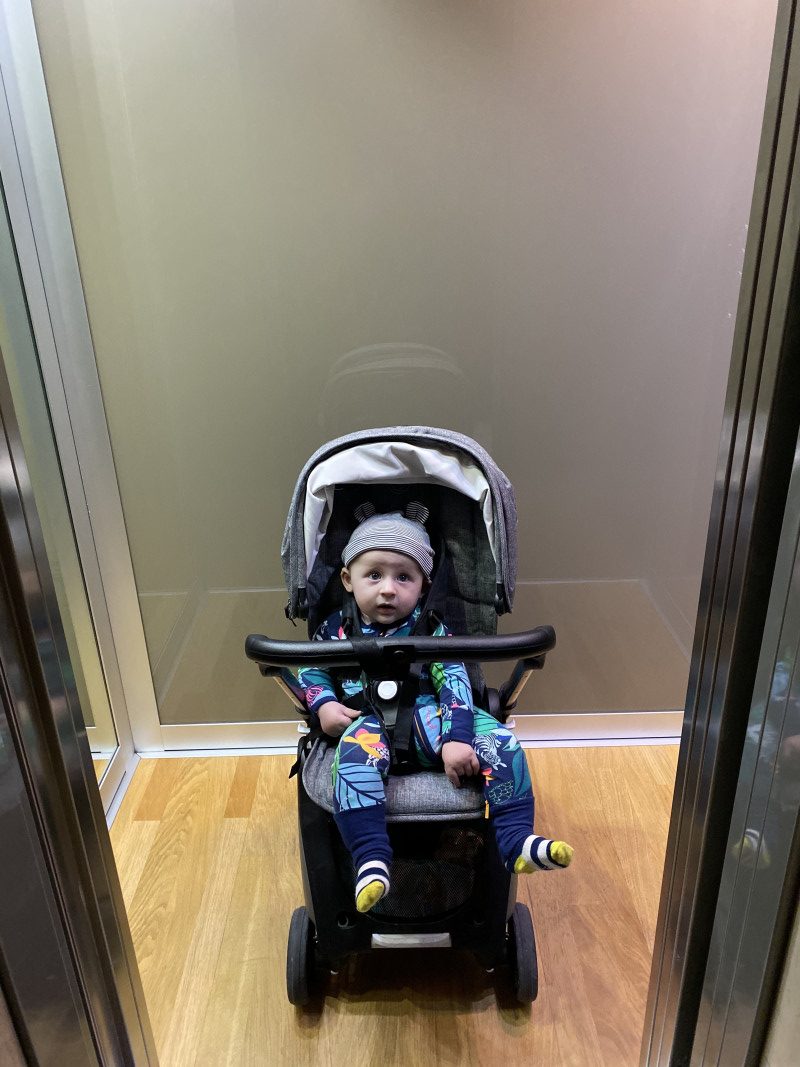

c) You Often Need to Lift Your Stroller to Get Into Public Transportation
Catching public transport can be challenging with a heavy stroller in many cities, such as Rome, Paris, Valetta, Warsaw – just to name a few.
Not all buses, metro, or trams have a flat entry, so you need to lift your travel stroller to pass the gap or a step. Not something you want to do with anything but a lightweight stroller. Some public buses in Verona were those old school buses with just an aisle where the stroller doesn’t fit at all so you need to fold the stroller quickly, take the baby out, and bring all their things up the bus’s stairs.
The entrances and exits to get in and out of the subway system are also often not wheelchair accessible or stroller accessible, so there are times when you will have to take the stroller entirely apart, lift it over the top of the gates, and then walk through while putting your child in your arms.
It’s not difficult with a small stroller, but if you’re coming with a giant stroller fully packed with stuff underneath, it can turn into a nightmare, especially in crowded places in the summer.
d) Strollers Aren’t Allowed Everywhere
Many historical sites and sightseeing places do not allow strollers in and may require you to leave them at the entrance, unattended. Unless you invest in a bike locker, a smaller lightweight stroller you can easily carry with a shoulder strap or stored at the ticket booth.
This happened on every occasion in Matera in Italy. We (barely) managed with giant wheels, but to be perfectly honest it was mostly I carry the baby and my husband carries the stroller.
Looking back, we should have had a baby carrier instead, but when it’s hot outside it’s not always the best solution as it doesn’t store anything. These days we bring both and use them depending on the occasion.
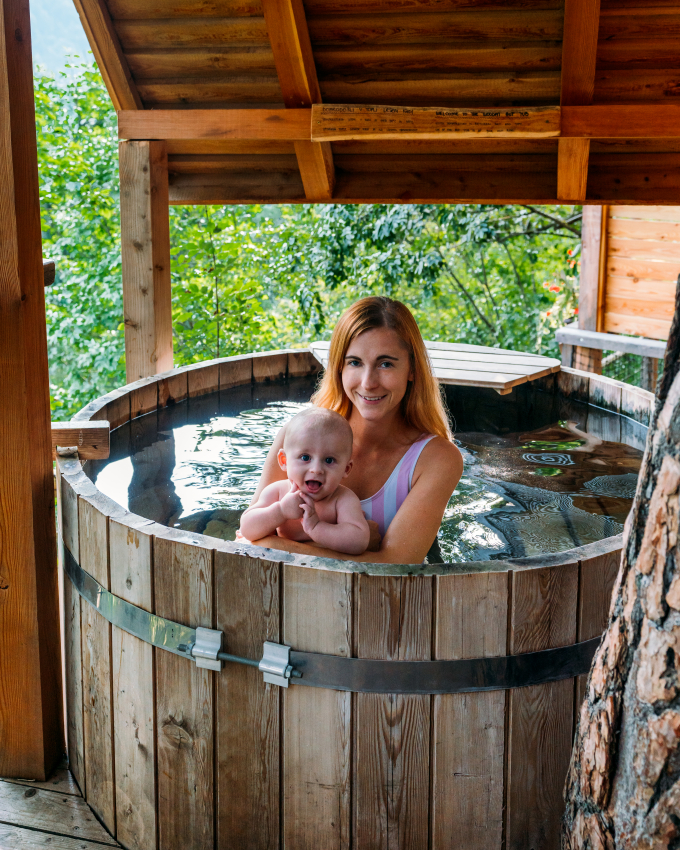
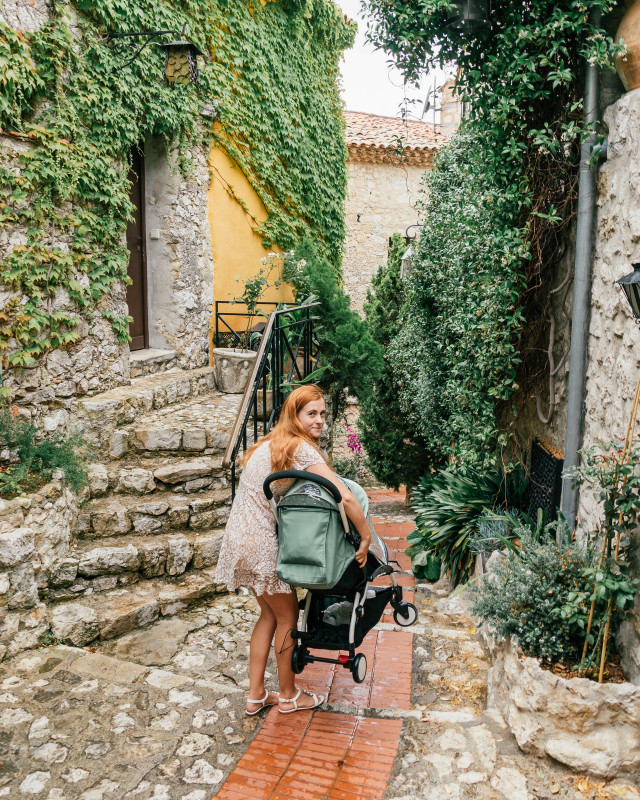
Things to Consider About a Travel Stroller for Europe
Sturdy Frame
Lightweight travel strollers, also known as umbrella strollers with cheap frames, tend to fall apart on cobblestones within 5 minutes. This is why most Europeans gave up on traditional old-style umbrella-type strollers, especially in places with beautiful old towns like Italy, the Czech Republic, or Malta.
Suspended Wheels
While everyone will tell you that big wheels are a must, I found that it’s not the case with the size, but the quality of the wheels and the suspension.
Small wheels of Babyzen Yoyo stroller or Cybex stroller work just fine on cobblestones and curbs, but GB Pockit+ with the same size of wheels struggled everywhere. More on my stroller comparisons here.
Don’t even think about cobblestones without suspension on your wheels, unless you’re up for a backache on your first day.
Recline
If you want to enjoy the European lifestyle, where kids are out in restaurants past 10 PM, you need to think about reclining.
Unlike in the US where most babies ride in a cat seat on top of the stroller, in Europe bassinets are a big thing. You will be yelled at for dragging your child around in things like Doona or car seats, because it’s simply unhealthy for a baby’s spine to use car seats as strollers for infants.
Fun fact: due to laws many strollers in Europe can fully recline while in the US they can’t lie completely flat. If you don’t have a stroller yet and the completely flat recline matters, you might look into purchasing a stroller in Europe after arrival.
One-Hand Fold
One-hand fold is a must, especially for airports and quick folding when needed on public transportation.
Large Canopy
Most travel strollers have a tiny canopy, which leaves the kids exposed to the sun and screaming. As the sun is horrible to babies, make sure that the canopy is large enough or/and bring an extra shawl to cover your baby.
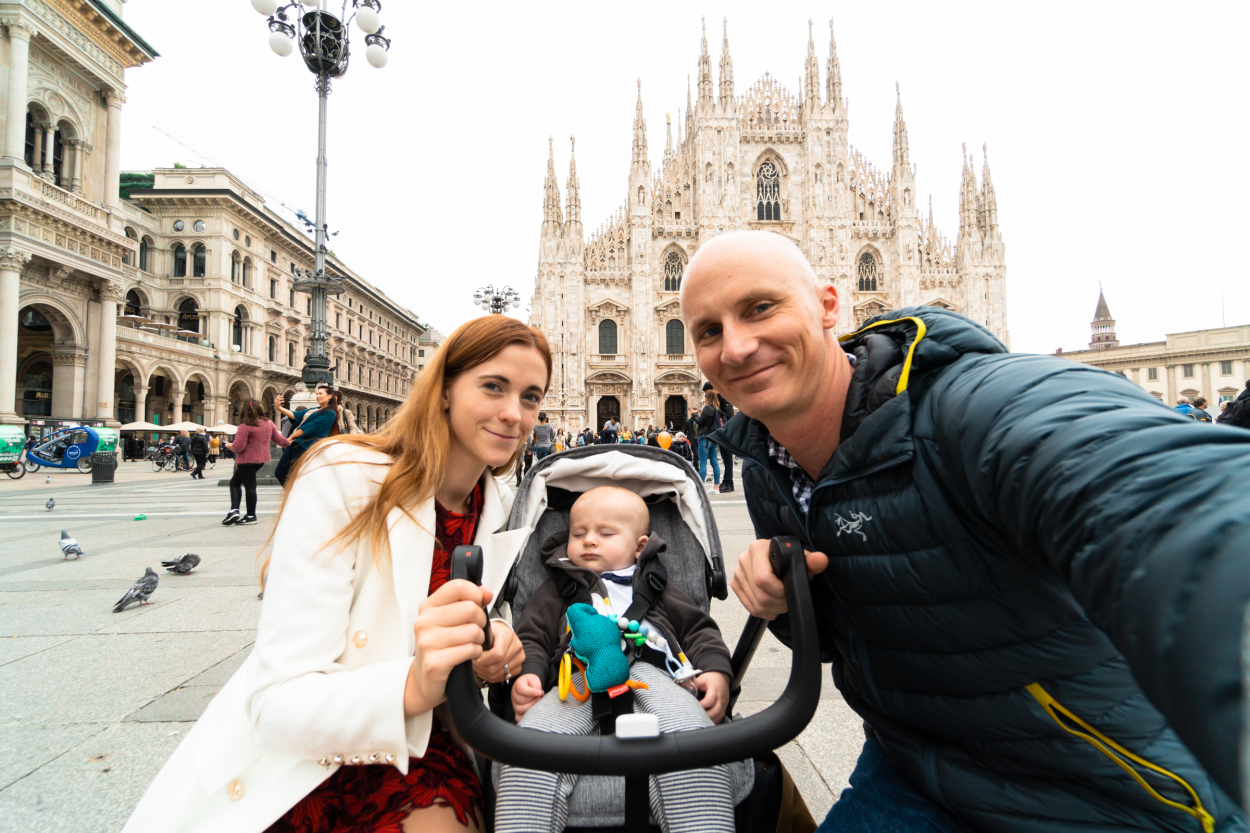
Car Seats in Europe
The car seat issue is tricky. Technically, American car seats are illegal in Europe and Canada too.
We used our American car seat for months in Europe without realizing it, but if we were stopped we could have paid a fine. If we got into an accident, insurance companies could refuse coverage if the car seat was not EU-approved.
Europeans require that the child be removed from the car seat in a single motion, which means a chest clip is a big NO.
Another difference is ISOfix and LATCH attachment. The third difference is that all US-certified forward-facing car seats must have a top-tether strap. European forward-facing car seats are not required to have a top-tether strap although some heavier ones will.
Staying in a Hotel in Europe with a Baby: What to Know
The first and most important thing is to check whether the hotel you’re planning on booking actually accepts kids. Many hotels, especially in more popular spots like Positano or Santorini, aren’t kid-friendly. In fact, you cannot even go to their restaurants with kids. However, it doesn’t mean that you should rule these destinations out!
If you’re booking a fancy hotel always call them and check with them about their kid regulations. I actually gave up on staying at one hotel in Italy because Booking.com said “hotel not suitable for children” but when I called it turned out it was just a mistake in the system.
While it’s understandable that some people prefer kids-free stays, make sure you check the rules. I also noticed that some hotels accept kids, but only over 8 years old. Always check the small print and kids’ rules.
Personally, with one child we never traveled with a pack-and-play travel crib, simply because it’s too much to carry and you can just ask for one wherever you stay.
I transitioned my kids to Montessori floor bed once they were mobile, so they slept on the floor mattress in hotels until he was 1 if a crib wasn’t available for some reason. Later, we got inflatable and travel-friendly bed bumpers and they slept on a bed these days.

Occupancy Issues When Booking Rooms
One thing that’s not often talked about is the issue of booking hotels with a baby and kids. Many European hotels might not offer bigger rooms and have occupancy limits due to local laws.
This means that even if your baby is a couple of months old and sleeps with you or in a crib (whether provided or your own) it might count as a person. As a result, you often cannot book a double room for 3 occupants and things get even more complicated once your baby is over 12 months old.
With 2 kids finding a hotel that doesn’t require us to book 2 separate rooms or a giant suite can be tougher, since babies or toddlers won’t stay in a separate room alone.
Most online reservation systems won’t take 2 kids (regardless of how small), so always email the hotel and ask if it’s possible to create a custom booking for you with the correct amount of people.
Many people will tell you just not to include children on your booking and show up, but I must advise against it.
I’ve managed to do it before without an issue, but I also know instances where people were turned away (for example, don’t try it in Paris or anywhere in Switzerland because most won’t let you get away with it), or asked to pay for another room on the spot or pay a ridiculous fee. You don’t want to be stranded with kids in town looking for alternative hotel options upon arrival.
Cultural Differences & Baby Treatment in Europe:
It’s impossible to generalize and say ‘this is how Europeans treat babies’, because Europe – while small compared to the US, has different cultures and hence people act differently.
Traveling with a Baby to Italy
Italy is considered a very baby-loving place – they love children and will make every effort to make you and your kids feel welcome. However, baby products are expensive compared to the US (apart from clothes) and I can honestly say that baby facilities in public places are lacking.
Most restaurants don’t have to change tables, so I often have to change my baby on a bathroom floor or in a sink (this is why changing mat is a must!), as you can’t even roll the stroller inside (doors are too small and bathrooms are usually up or down the stairs).
The staff makes up for the lack of facilities and always wants to play with the baby, show you photos of their babies, and even sing the songs.
Crying baby at the restaurant? People will ask if they can help or tell you that it gets better.
The love for babies comes with people always wanting to stop and stare inside your stroller, or make faces at them in the supermarket for a long time. It’s slightly annoying if you ask me, but my now-toddler totally brought this habit back to the US from Italy and always bugs strangers at the supermarket these days.
More on Traveling with a Baby to Italy

Traveling with a Baby to France
From my observations kids in France were super well-behaved, babies included as they’re taught to behave from day 1 of their lives. People were friendly to babies, but without the obsessiveness which was quite refreshing to me after Italy.
Facilities were always slightly limited, similar to Italy, but I’d still say it’s one of the best places in Europe to travel with a baby. Even in the middle of Paris we had no problem navigating with kids and there were plenty of playgrounds everywhere, all over the country – even at roadside rest stops.
There aren’t kids menu at restaurants, because French kids eat whatever adults eat. If you see a kids’ menu the restaurant might be a big tourist trap.
French like to dress their babies in heavy jackets, hats, and gloves even if it’s not very cold outside. We got some strange looks when my kids were in jumpers when it was about 65 F outside.
I swear everyone has a Yoyo stroller in France. It’s a French company, so it’s not surprising but French people are practical with strollers it seems.
More on Traveling with a Baby to France

Traveling with a Baby to Poland
I didn’t think that anyone really ever cared for my baby in Poland (my first son was born in Poland) and when we brought Holden it was the same thing. No special treatment, no extra accommodation at restaurants.
Unless he was outside without a baby hat haha. Polish grandparents have an obsession with babies having to have a hat on, so when we were rolling outside without it people would loudly ask “where is his hat?”.
While I had friendly people helping me get on and off public transportation, no one really stared inside my stroller to see what the baby looked like.
Surprisingly, I found Poland a great place for baby travel. There are plenty of new playgrounds everywhere, and many malls even have feeding and changing rooms with microwaves, milk heaters and calming music.
In Warsaw, I was also able to bring Dylan to a spa during certain hours, which was wonderful.

Traveling with an Infant to Malta
Malta was definitely not a baby-friendly place in my eyes. I traveled there on my own when my LO was just a few months old and encountered a nightmare.
Getting into public transportation was a mission impossible, most taxis didn’t even have seatbelts, streets were narrow (if there was even a sidewalk in some parts of the island like St Julians), non-existent facilities, and everywhere was way overcrowded.
When I was traveling with my Babyzen Yoyo stroller many local women stopped me asking whether I got it in Malta, as they’d love to have one. Overall, it was a weird experience and not my favorite.
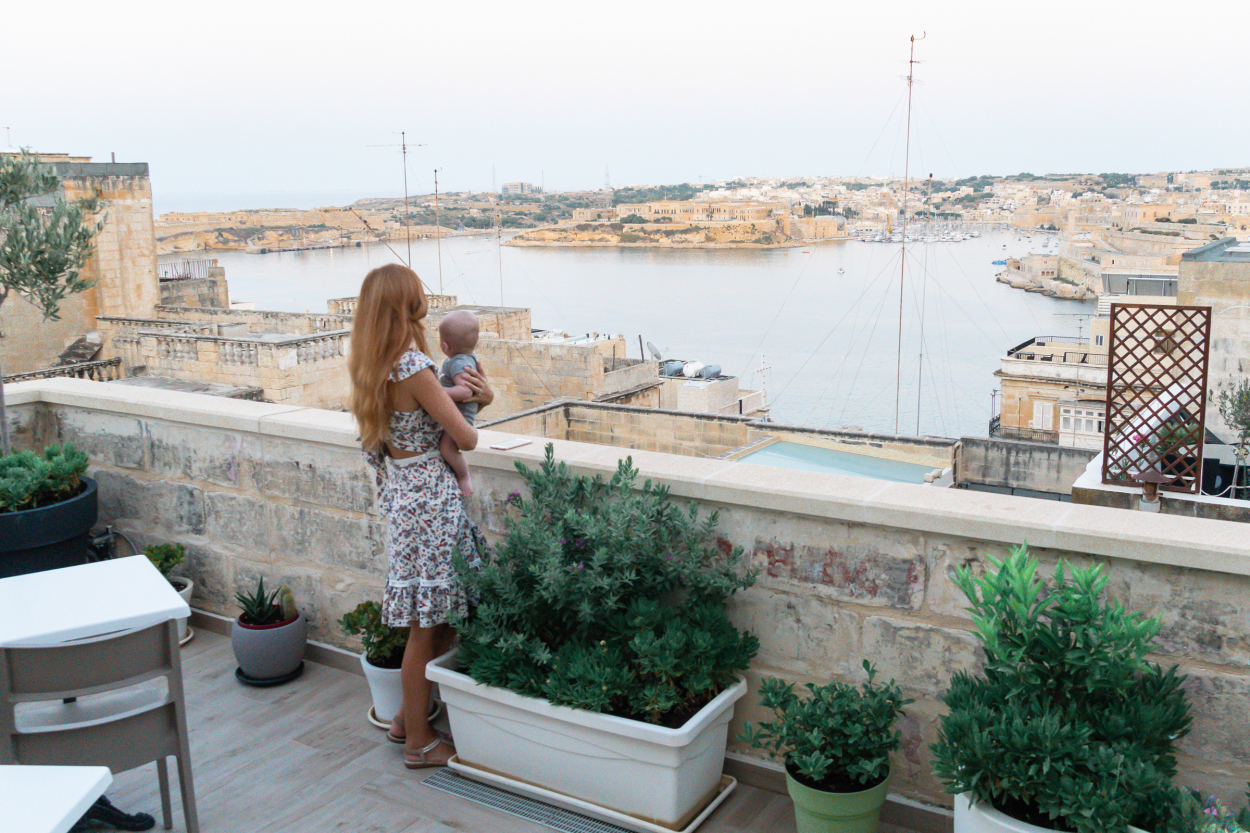
Traveling with a Baby to Greece
Greece is a fantastic place to visit with kids. Greeks love babies and every place we visited in Greece was very kid-oriented. Friendly street cats help with entertainment as well.
Children are welcome at restaurants, and sunset bars, and will get accommodated accordingly. Most places outside of Athens are full of cobblestones and stairs but there are also areas that will have flat strolls with only a few steps, which gives you two options: either bring a baby carrier or bring a small lightweight stroller you can carry if needed.
Your baby or toddler won’t go hungry in Greece for sure, as there’s always some fries, pasta, or bread. Or olives, both my kids love olives.
More on Traveling with a Baby to Greece
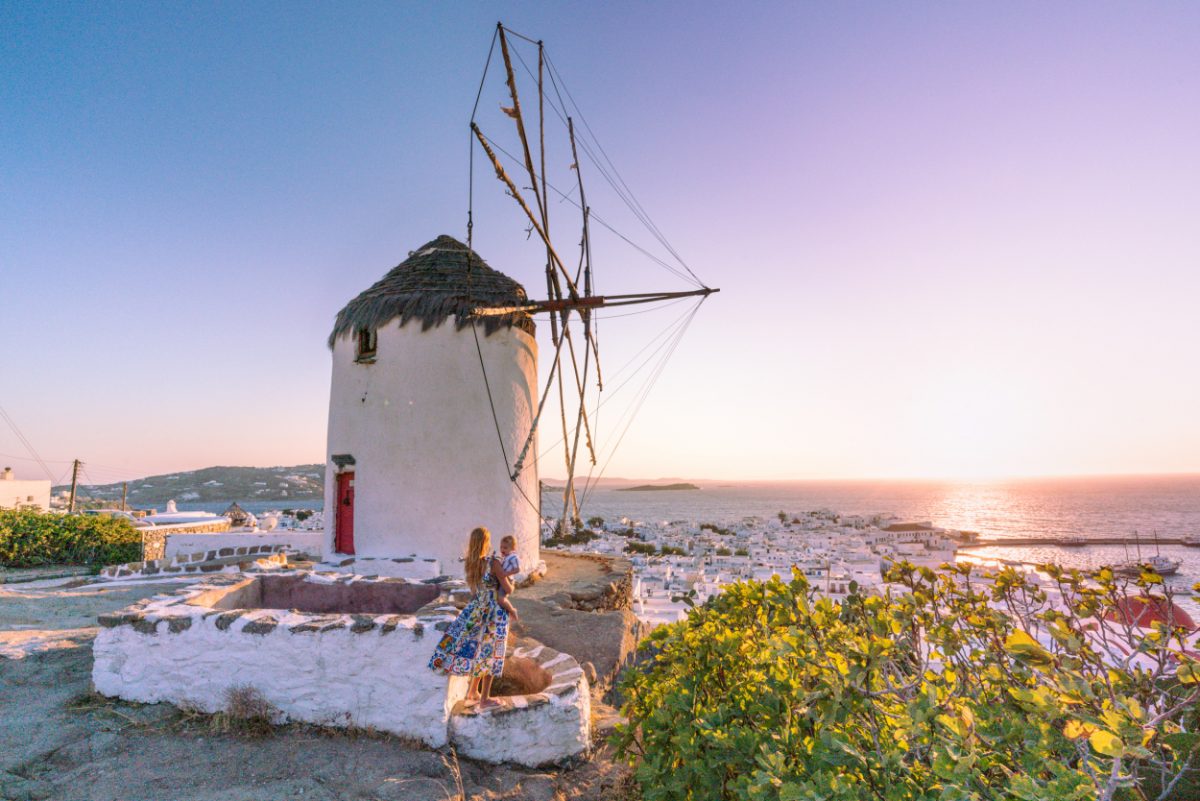
Traveling with a Baby to Spain
We only visited Andalusia and Catalonia and we found it very accepting for babies, but felt the attention just like in Italy. There were no ramps anywhere for a stroller and elevators and doors were even smaller than in Italy, so it wasn’t entirely baby-friendly in terms of facilities.
We didn’t stumble upon ‘no kids allowed’ anywhere, in fact, it’s totally normal to bring babies to a bar and bartenders were giving them fruits as a free treat. But, at restaurants the wait for any food was long (not to mention many didn’t even open until 8 PM) and toddlers were getting antsy. Getting a waiter’s attention was a challenge itself, so forget about milk being heated – we didn’t even bother to try.
We always felt pushed around even with a stroller at train stations, waiting in lines, it seemed like people just didn’t care that they could fall on a baby which wasn’t the nicest experience (I actually had to push one old lady away when she tried to climb over our stroller because she wanted to skip the line, which turned into a giant fight).
The airport playground in Valencia was taken over by hangover adults in the middle of the day and the staff seemed unbothered. That said, while many claim Spain is very baby-friendly I would rather call it a “baby or kids-accepting country”, but it felt more relaxing in other places.
More on Traveling to Spain with a Baby

Traveling with a Baby to Slovenia
Slovenia was a fantastic place to go with a baby. Everyone was always friendly and accommodating, even if their facilities didn’t necessarily allow that.
Most touristy spots were flat, didn’t stumble upon ‘no kids allowed’ at any hotels – in fact, everywhere we went there were plenty of kids including glamping spots.
We were able to rent a boat, eat out and enjoy ourselves without a feeling that we’d bother anyone.

Traveling with a Baby to Austria
Austria can be a good place to take your kids, as it’s very rule-oriented. We found Austria very accommodating, even when we were very confused tourists 😉
Nobody will be hopping around your baby or give you priority for anything (looking at your Vienna with long lines to enter many restaurants), but people are nice to kids in their ways.
Bigger cities like Vienna or Innsbruck will have perfect facilities like elevators to enter every metro station or ramps at tourist attractions to accommodate strollers.
Your child won’t be hungry, because there’s always something that kids like. Whether it’s a traditional wurst, bread, or pasta, there’s stuff to eat even if a place doesn’t cater to kids specifically.
Austria is also a leading market for Kinderhotels, which are incredible with babies, toddlers, or preschoolers.
Traveling with a Baby to Switzerland
Switzerland, while obviously expensive to visit as a family, has everything ready for babies, toddlers and kids. It’s a fantastic place to go with a baby and the facilities are always spotless and perfect. Everyone is always friendly and accommodating, even if their facilities aren’t adjusted they will find you a crib or high chair.
The only issue when traveling with small kids is that they won’t be allowed up to some mountains due to elevation – usually, the minimum age is 1 year, but some say 3+ years.
More about Visiting Switzerland with Kids

Traveling with a Baby to Sweden
Sweden, similar to any other spot in Scandinavia is immensely baby and kid-friendly. But, without sacrificing the comfort of adults as well. Your baby and toddler will be welcome everywhere and things will be accessible.
Want to go to a museum? Absolutely, and while you’re reading a “boring to a toddler” exhibit, there’s always something for them to mess around with.
Facilities were always accessible and available for babies, whether it was a park or a restaurant.
See more on Sweden with a Baby or Toddler
Traveling with a Baby to the Netherlands
The Netherlands is a country of the happiest kids in the world. As places are very walkable, it’s easy to get around with a baby in a stroller, but it’s not unusual to see Dutchies biking around with a baby in a little bike seat. Make sure to have a raincover though as it obviously rains a lot in Holland.
Children are welcome at restaurants and invited to be themselves. There are many childproof playcafes, but most of them are slightly hidden so don’t hesitate to ask for a baby area in the back.
Dutch are known to be very stoic, so if your baby cries in public nobody will bat an eye, as it’s just considered normal.
Any questions about traveling to Europe with a baby?


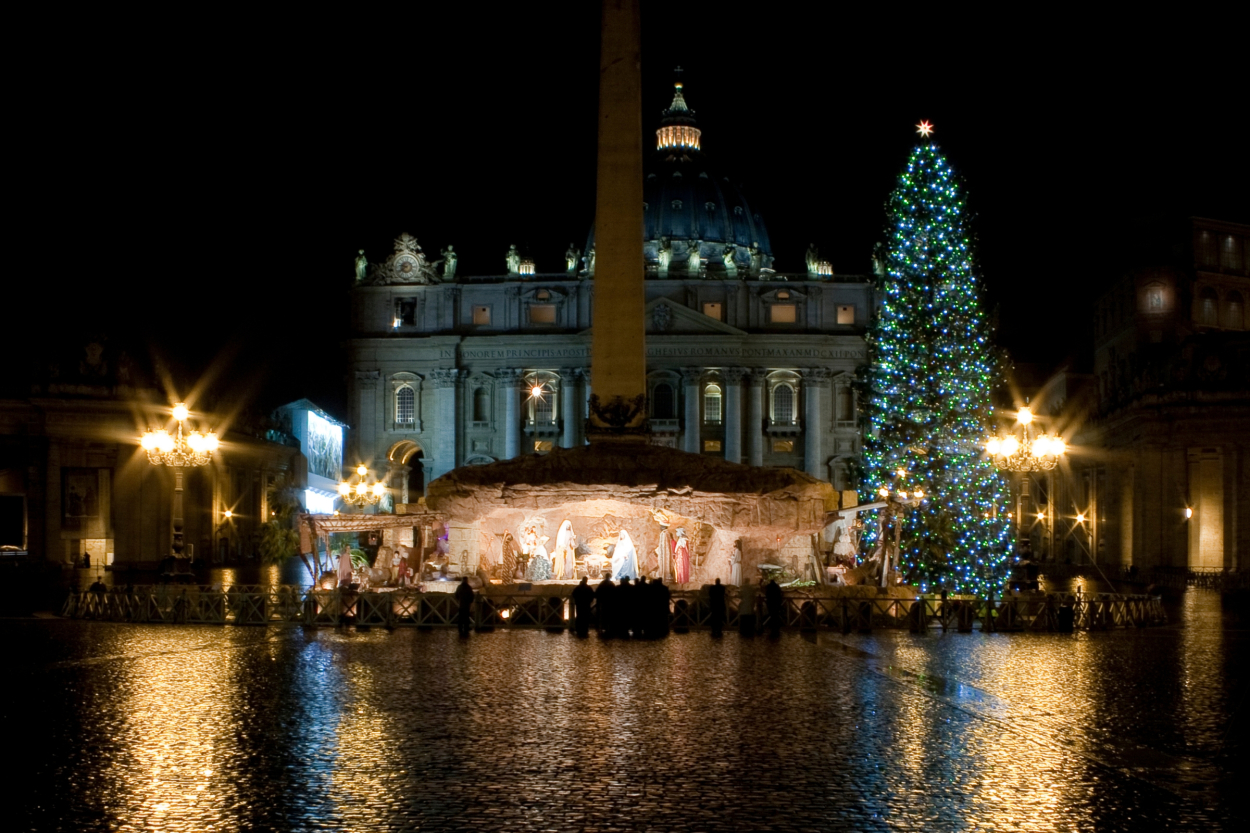


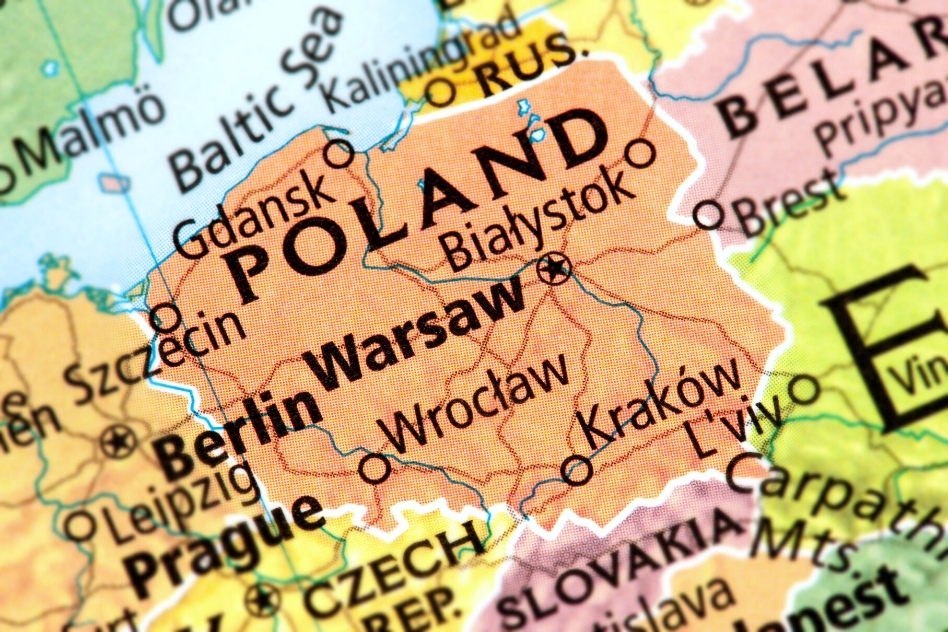

Anna, you guys are amazing traveling with a baby. I’m sure you always know where the closet hospitals are.
Not really to be honest – hospitals are simply everywhere and so far we’ve never needed to go 🙂
You people are great. However, travelling with baby is sometimes a headache.
Hi Anna, I’m reading your blog with great interest as we’re expecting our first child while living in Italy. I think we’ll probably travel mostly by car and train and avoid planes while baby is very young, but I’m extremely nervous about flying to the UK next summer when she’s about 7-8 months old. I’ll probably be alone with her and I’ll have to take a plane, a train, and a ferry as minimum. The trip usually takes me about 10-12 hours as my family lives on an island… any advice you have would be amazing!
First of all – good luck with the birth! 🙂 As we just traveled again with ours now when he’s a toddler I can assure you that flying with a baby was a breeze comparing to now, haha. At 7-8 months she should still be fairly easy, they sleep a lot and as long as they see something interesting (being outside is already interesting) it should be fine. She still most likely won’t be walking, if she crawls by then you could always find an area for her to try it out. Many Italian airports have play areas and lounges also might have some baby rooms.
What secrets do you have regarding the time zone switch with a baby? I am going to Italy in June with my 11 month old and looking for any tricks
Every time we traveled internationally we just allowed one more nap during the first two days and kept the kids up until at least 7pm to get them used to the new day time schedule. Never had an issue to be honest.
Really enjoyed reading this. Now that your baby is older, what car seat do you use in Europe? My son is going to be 3 in Nov and we are going to Europe in July for 3 for 3 weeks. Can I buy a European car seat here in the US? If not, our European relative can buy it for us and install it so that when we arrive it is ready. What is a European car seat that is lightweight and inexpensive?
Most European car seats are cheaper, lighter, and more portable than American ones actually so that’s good news. We were just living back in Europe for a few months again and bought Nachfolger for the 1 year old and most 3-year-olds would fit (you can order it to the US as well) and it’s great in terms of portability and comfort, but that’s rear-facing so both of my sons refused it. But it’s a nice one 😉
My 3 year old is also 100 cm tall, so he fits into the 3+ year category or seatbelts car seats or even in mifold. Rules vary per country, but in most places 15kg/33lbs ride in a booster with seatbelts and that’s what most taxis and private transports had and we just got one of this for our car: https://www.bebe9.com/siege-auto-gr-2-3-viaggio-shuttle-crystal-black.html (we had a different brand that was about 50 EUR but can’t find a link, but it’s the same concept basically). Alternatively, you can get something like this: https://www.bebe9.com/siege-auto-gr-2-3-solution-b2-fix-steel-grey.html
Another portable car seat is Maxi Cosi Nomad (also folds), but unless you’re planning on traveling with your kid soon or have another I’d just get some of those above.
I am travelling to Spain this summer with a 2 year old and a six month old, a travel stroller doesn’t seem feasible as both children would be using the stroller. Is it really a big issue taking something equivalent to a Nuna?
Having just returned from Spain with kids only a few months older than yours I will advise against something like Nuna. I was especially looking around at other people’s families and all of them had the same setup like us: one kid one travel stroller or a buggy board. Especially in places like Spain have a LOT of stairs or you’ll be carrying the stroller, narrow corners (not even in and out of buildings, but to pass by because many eat outside), not to mention your stroller won’t even fit into various elevators in the fanciest hotels that actually have elevators (we had to bring strollers one by one and they barely fit) and if we had anything bigger than Babyzen Yoyo or Cybex Libelle we wouldn’t be able to fit on the bus or insert it in the trunk of a taxi. Get two travel strollers or a buggy board for the 2 years old – we have both but if we explore all day then bring the stroller. If we take breaks at the hotel then the older siblings has a buggy board.
Great information! I will be taking my 3 year old and 1 1/2 year old to Norway and Sweden this summer and I’m debating not bringing a stroller at all, but possibly just a carrier. Would you advise against this?
Depends on your kids… my younger son refuses a stroller and wants to walk, but naturally since he’s not even 2 it takes him forever and ever to get anywhere. But, I cannot imagine having him in the carrier at this age either (unless it’s a hiking backpack for actual hiking), because he’s big. My 3 year old was fine walking on short distances (we also had his balance bike), but if you’re out and about all day (eg. when I went to Spain we were out of the hotel 9am to 9pm, so stroller was much needed for the 3-year-old as well.
Hello, my question is about visas. Does my newborn with an American passport require a visa to enter Europe/ Finland?
At the moment Americans don’t need visas to Europe, so you can just go. The launch of the ETIAS travel authorization is currently slated for November 2023, so once this is launched all Americans will need to register and pay a small fee to receive travel authorization but it’s going to be a very easy and straightforward process.
@Anna Karsten,
Hello Anna, we are currently living in Poland and planning to visit Spain with a 6 month old baby, born in Poland with a Philippine passport. Without a TRC yet,can my baby travel with us or we should get a visa for her?
Since the baby was born in Schengen their status is basically “tolerated” which means that the baby is good until they leave the zone. However… it’s been over 90 days since the baby is 6 months old, so in rare circumstance you might be asked to leave if you stayed more than 90 days without residency.
You can’t really apply for a visa because your baby is already in Schengen zone.